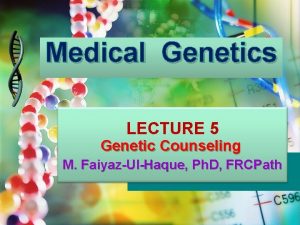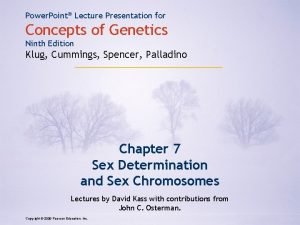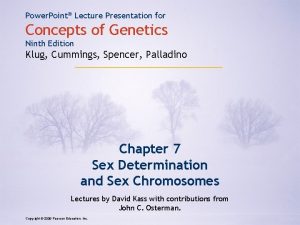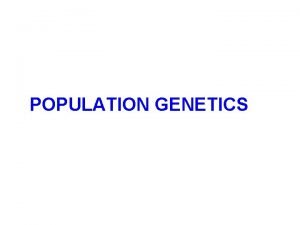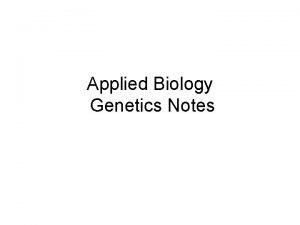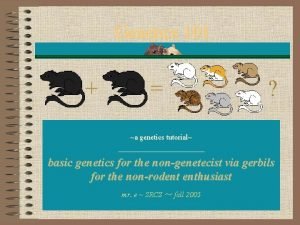Power Point Lecture Presentation for Concepts of Genetics









































- Slides: 41

Power. Point® Lecture Presentation for Concepts of Genetics Ninth Edition Klug, Cummings, Spencer, Palladino Chapter 2 Mitosis and Meiosis Lectures by David Kass with contributions from John C. Osterman. Copyright © 2009©Pearson Education, Inc. Copyright 2009 Pearson Education, Inc.

Copyright © 2009 Pearson Education, Inc. Figure 2. 1

What are the differences between prokaryotic and eukaryotic organisms? Try to come up with 3 Copyright © 2009 Pearson Education, Inc.

Name some of the main representative types of organisms in each group Prokaryotic Copyright © 2009 Pearson Education, Inc. Eukayrotic

Organisms organize DNA in structures called chromosomes. Which is prokaryotic, (a) or (b) (a) A. [Default] B. [MC Any] C. [MC All] Copyright © 2009 Pearson Education, Inc.

Parts of a chromosome Copyright © 2009 Pearson Education, Inc.

The structure labeled 2 is: A. centrosome B. centromere C. centriole Copyright © 2009 Pearson Education, Inc.

The structure labeled: A. p arm B. monad C. q arm Copyright © 2009 Pearson Education, Inc.

Cell Division • Prokaryotes • Binary fission • Eukaryotes • transmission of genetic material from one generation of cells to next involves: • Mitosis +cytokinesis • Meiosis + cytokinesis http: //www. youtube. com/watch? v=m 73 i 1 Zk 8 EA 0 Copyright © 2009 Pearson Education, Inc.

E. coli – Binary Fission Copyright © 2009 Pearson Education, Inc. Figure 2. 2

Section 2. 2 – Homologous Chromosomes • In each homologous pair of chromosomes, one member is derived from each parent. Identify location of: • Sister chromatids • Centromere • Kinetochore • Telomeres Standford. edu. 2010. http: //www. stanford. edu/group/hopes/basics/dna/f_b 11 homolgs. jpg Copyright © 2009 Pearson Education, Inc.

Copyright © 2009 Pearson Education, Inc. Figure 2. 3

Diploid vs Haploid Organisms • Diploid Organisms • 2 copies of each chromosome for most of its life cycle • Haploid Organisms • 1 copy of each chromosome for most of its life cycle • Ex. Bacteria, yeasts and molds, some plants such as bryophytes (mosses) Copyright © 2009 Pearson Education, Inc.

Mechanism of chromosome separation • http: //www. youtube. com/watch? v=YAva 4 g 3 Pk 6 k Copyright © 2009 Pearson Education, Inc.

Use the karyotype to identify sex: A. Female B. Male Copyright © 2009 Pearson Education, Inc.

When Does Mitosis Occur? • Multicellular Organisms • Growth • Tissue repair • Cell replacement of certain tissues (e. g. epidermis – skin) • Single-celled Organisms (prok and euk) • Asexual reproduction Copyright © 2009 Pearson Education, Inc.

Mitosis – two main processes • Karyokinesis • Genetic material is partitioned to daughter cells during nuclear division • Cytokinesis • Cytoplasmic division follows. Copyright © 2009 Pearson Education, Inc.

Cell Cycle Copyright © 2009 Pearson Education, Inc.

Cell Cycle Copyright © 2009 Pearson Education, Inc.

Mitosis • Mitosis has discrete stages: • • • prophase prometaphase anaphase telophase (see Figure 2. 7) http: //www. youtube. com/watch? v=DD 3 IQkn. CEdc Copyright © 2009 Pearson Education, Inc.

Copyright © 2009 Pearson Education, Inc. Figure 2. 7

Cell-Cycle Regulation and Checkpoints Copyright © 2009 Pearson Education, Inc.

Cyclin-dependent Kinases • Cell cycle is driven by enzymes called Cyclin-dependent kinases, or Cdk’s • Kinases are enzymes that phosphorylate (add a phosphate group to) other proteins • stimulates or inhibits protein’s activity • Cdk’s are active only when they bind to other proteins called cyclins Copyright © 2009 Pearson Education, Inc.

Enzymes Drive the Cell Cycle • Cell division occurs when growth factors bind to cell surface receptors, which leads to cyclin synthesis • Cyclins then bind to and activate specific Cdk’s Copyright © 2009 Pearson Education, Inc.

Activated Cdk’s • Promote a variety of cell cycle events – Synthesis and activation of proteins required for DNA synthesis – Chromosome condensation – Nuclear membrane breakdown – Spindle formation – Attachment of chromosomes to spindle – Sister chromatid separation and movement Copyright © 2009 Pearson Education, Inc.

Copyright © 2009 Pearson Education, Inc.

Meiosis • Meiosis reduces the amount of genetic material by one-half to produce haploid gametes or spores containing one member of each homologous pair of chromosomes. Copyright © 2009 Pearson Education, Inc.

Meiosis • Meiosis I and II each have prophase, metaphase, and telophase stages (Figure 2. 10). Copyright © 2009 Pearson Education, Inc.

Meiosis Copyright © 2009 Pearson Education, Inc. Figure 2. 10

Meiosis • Prophase I has five substages, each including specific events (see Figure 2. 9): • • • leptonema zygonema pachynema diplonema diakinesis • At the completion of prophase I, the centromeres of each tetrad structure are present on the equatorial plate. Copyright © 2009 Pearson Education, Inc.

Prophase I Additional Terms to Know: • Synapse • Tetrad • Crossing over Copyright © 2009 Pearson Education, Inc. Figure 2. 9

Meiosis I • Metaphase I, and telophase I are similar to those of mitosis. Copyright © 2009 Pearson Education, Inc.

Meiosis Copyright © 2009 Pearson Education, Inc. Figure 2. 10

Meiosis II • During meiosis II, the sister chromatids in each dyad are separated to opposite poles. • Each haploid daughter cell from meiosis II has one member of each pair of homologous chromosomes. Copyright © 2009 Pearson Education, Inc.

Disjunction and Nonjunction • Disjunction • Separation of homologous chromosomes • Nondisjunction • during meiosis I or II leads to gametes with abnormal numbers of chromosomes and can lead to abnormal offspring. Copyright © 2009 Pearson Education, Inc.

2. 5 The Development of Gametes Varies in Spermatogenesis Compared to Oogenesis Copyright © 2009 Pearson Education, Inc.

Section 2. 5 • Male gametes are produced by spermatogenesis in the testes (Figure 2. 11). • Female gametes are produced by oogenesis in the ovary. Copyright © 2009 Pearson Education, Inc.

Copyright © 2009 Pearson Education, Inc. Figure 2. 11

Importance of Meiosis • Mechanism of meiosis is basis for production of extensive genetic variation. • Gametes receive either the maternal or the paternal chromosome from each homologous pair of chromosomes. • An organism can produce 2 n (where n represents the haploid number) combinations of chromosomes in gametes. Copyright © 2009 Pearson Education, Inc.

Life Cycles Differ in Certain Organisms • Diploid life cycle • Ex. Humans and other animals • Haploid life cycle • Ex. Fungi, protists • Alternation of generation • Plants Copyright © 2009 Pearson Education, Inc.

The End Copyright © 2009 Pearson Education, Inc.
 Medical genetics lecture
Medical genetics lecture Human genetics concepts and applications 10th edition
Human genetics concepts and applications 10th edition 01:640:244 lecture notes - lecture 15: plat, idah, farad
01:640:244 lecture notes - lecture 15: plat, idah, farad Presentation in hindi topic
Presentation in hindi topic Power point presentation design west vancouver
Power point presentation design west vancouver Draw the power triangle
Draw the power triangle Power bi training powerpoint
Power bi training powerpoint Point point power
Point point power Lecture presentation software
Lecture presentation software Power system dynamics and stability lecture notes
Power system dynamics and stability lecture notes Zline 667-36
Zline 667-36 Power semiconductor devices lecture notes
Power semiconductor devices lecture notes Switch mode power supply lecture notes
Switch mode power supply lecture notes Power system dynamics and stability lecture notes
Power system dynamics and stability lecture notes What is the point of uchendu’s lecture to okonkwo?
What is the point of uchendu’s lecture to okonkwo? Kontinuitetshantering
Kontinuitetshantering Novell typiska drag
Novell typiska drag Tack för att ni lyssnade bild
Tack för att ni lyssnade bild Returpilarna
Returpilarna Varför kallas perioden 1918-1939 för mellankrigstiden
Varför kallas perioden 1918-1939 för mellankrigstiden En lathund för arbete med kontinuitetshantering
En lathund för arbete med kontinuitetshantering Kassaregister ideell förening
Kassaregister ideell förening Tidbok för yrkesförare
Tidbok för yrkesförare A gastrica
A gastrica Förklara densitet för barn
Förklara densitet för barn Datorkunskap för nybörjare
Datorkunskap för nybörjare Tack för att ni lyssnade bild
Tack för att ni lyssnade bild Debattinlägg mall
Debattinlägg mall Delegerande ledarskap
Delegerande ledarskap Nyckelkompetenser för livslångt lärande
Nyckelkompetenser för livslångt lärande Påbyggnader för flakfordon
Påbyggnader för flakfordon Vätsketryck formel
Vätsketryck formel Publik sektor
Publik sektor Lyckans minut erik lindorm analys
Lyckans minut erik lindorm analys Presentera för publik crossboss
Presentera för publik crossboss Argument för teckenspråk som minoritetsspråk
Argument för teckenspråk som minoritetsspråk Kanaans land
Kanaans land Treserva lathund
Treserva lathund Fimbrietratt
Fimbrietratt Claes martinsson
Claes martinsson Centrum för kunskap och säkerhet
Centrum för kunskap och säkerhet Lågenergihus nyproduktion
Lågenergihus nyproduktion
